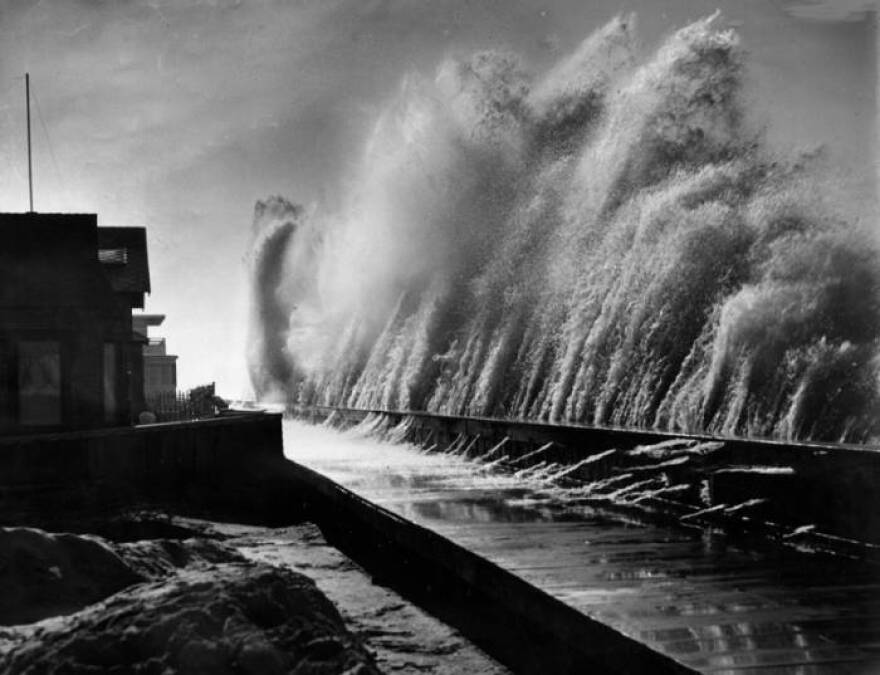Truth matters. Community matters. Your support makes both possible. LAist is one of the few places where news remains independent and free from political and corporate influence. Stand up for truth and for LAist. Make your year-end tax-deductible gift now.
The Last Time A Tropical Storm Hit LA, It Was 1939. Nearly 100 Died

Hurricane Hilary is driving its way up the Pacific Coast. When it touches down in Southern California as expected, it could be a once-in-a-century event.
Earlier this week, Hilary grew from a tropical storm to a Category 2 hurricane. On Friday, it strengthened to a Category 4, though meteorologists believe it will ultimately weaken before it hits Southern California.
By the time the storm arrives in L.A., it could be downgraded to a post-tropical, low-pressure system.
But if it doesn’t, it’ll be the first tropical storm to reach L.A. since 1939. Whatever Hilary's final designation, brace yourself for some wet stuff this weekend. Flooding and mudslide warnings are already in effect. The latest AccuWeather.com forecast projects two to four inches of rain.
The history
The last time a tropical storm slammed into L.A., the year was 1939. The Long Beach Tropical Storm — nicknamed El Cordonazo or “The Lash of St. Francis” — struck in late September of that year in Long Beach and San Pedro. It dumped five inches of rain on the region in just 24 hours and was accompanied by wind gusts of up to 65 miles per hour. It also resulted in $2 million in damages (which would be more than $43 million today) to crops, power lines, shore structures and more.
Nearly 100 people died in flooding or at sea. A 150-foot section of the Southern Pacific Railroad was reportedly washed out. People were stranded in their homes.
Historical records from the National Weather Service say California residents were “generally unprepared” for the storm’s effects. In the aftermath of the destruction, the weather bureau created a Southern California forecast office that’s still running today.
Why are hurricanes so rare in SoCal?
Hurricanes usually only develop when ocean temperatures are at least 80 degrees, which doesn’t often happen in California. (The waters off Santa Monica, for example, typically range from the high 50s in winter to the high 60s in late summer.) California wind patterns are also unfavorable for hurricane formation.
But during a year with an El Niño climate pattern, which started this past June, wind shear is reduced, which increases the chances that there will be a storm. El Niño also increases water temperatures, sometimes, but not often, contributing to the perfect formula for a tropical storm.
Care to know more? This YouTube video does an excellent job of breaking down the role our unique weather patterns play in hurricane formation:
What Hilary might bring
The National Weather Service issued a rare Tropical Storm Watch throughout Southern California, including the counties of L.A., Ventura, Orange San Diego, Riverside and San Bernardino.
The deserts and mountains are expected to be particularly impacted, including the San Gabriel Mountains, as well as the Santa Clarita and Coachella valleys, the Antelope Valley foothills and the corridors of the 5 and 14 freeways.
Flood watches are in effect in Los Angeles and Ventura counties. From Sunday afternoon through Monday evening, “Flooding caused by excessive rainfall is possible,” according to the National Weather Service.
Residents could see up to an inch of rain falling in the span of an hour, potentially triggering landslides. “Be alert in the mountains for rockslides and rocks in the road,” the NWS cautioned.
The coast will also experience high surf and rip currents — mostly affecting south-facing beaches. The worst of the storm’s effects in L.A. will likely be Sunday evening into Monday.







